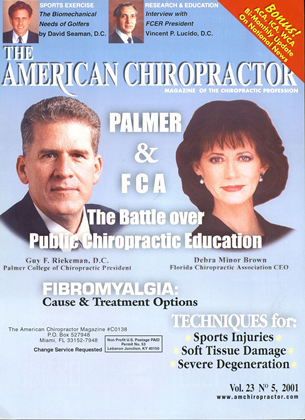Interview with FCER President, Vincent P. Lucido, D.C, PA. Dr. Vincent Lucido is a graduate of Hofstra University in New York, and a 1962 graduate of the Chiropractic Institute of New York. Thanks to the United States Army, however, he did not begin the practice of chiropractic until 1966. After his discharge from the army, he and his wife moved to Florida, where he began his practice, and became involved in the politics of the chiropractic profession in his state association and. then, in the American Chiropractic Association. He was appointed as a trustee from the AC A House of Delegates to the Foundation for Chiropractic Education and Research, in the early '80's, and. later, succeeded Dr. Mac McClelland as President of FCER. Dr. Lucido has practiced in Lakeland, Florida, since 1966. In an interview with The American Chiropractor (TAC), Dr. Vincent P. Lucido (VPL) answers TAC's questions concerning the Foundation for Chiropractic Education & Research (FCER). TAC: What is the FCER? VPL: FCER is the premier chiropractic research and education organization in the chiropractic profession. To better understand what FCER is, we need to consider its history. In the 1930\s. several chiropractors, with a vision for what the profession could become, banded together with a spirit of dedication and sacrifice. They each contributed $1,000 (a lot of money, considering we were still emerging from the great depression) toward the formation of a non-profit organization to be called the Chiropractic Research Foundation. Dr. A.W. Schwietert was the first president of the foundation, and he was the moving force in encouraging forty-two other chiropractors to contribute the $1,000. The name was changed toFCERin 1967. At present, our primary mission is to promote the health and well being of humanity, by encouraging and supporting research and education relative to the field of chiropractic care, and to provide information needed to document and improve chiropractic healthcare capacity worldwide. TAC: Since the FCER is involved with research, what specifically are your research priorities? VPL: FCER has three broad categories of funding research. They are clinical research, basic sciences research, and research fellowships (to enlarge the infrastructure of qualified investigators at our chiropractic institutions). Within those areas, our current priorities include somato-visceral conditions amenable to chiropractic management (asthma, otitis media, infantile colic, dysmenorrhea). repetitive stress syndromes, technique evaluation, the neurophysiology of the vertebral subluxation complex, efficacy and effectiveness of chiropractic management of chronic low back pain with sciatic and/or intervertebral disc hcrni-ations. headache, and endocrine responses to stress. TAC: What is the FCER's relevance to the chiropractic profession, advancement, and protection? VPL: We live in the age of accountability in the healthcare disciplines, and chiropractic is no exception. With this comes the necessity to be able to support what we do clinically, with Ji v i!mentation that is backed up by scientific evidence. While this is another burden on the back of the chiropractic physician, it is also a door of opportunity. If the health care consumer were able to have information that scientifically, rather than anecdo-tally. confirmed the success of chiropractic management of children with symptoms of asthma and otitis media, plus carpal tunnel syndrome, the demand for chiropractic services would increase. FCER is working in these vital areas of interest to the chiropractic profession. TAC: What can our readers do, if they'd like to participate with the FCER? VPL: I am amazed at how few know about FCER membership, and how it will help our efforts and benefit them. General membership on an individual basis is SI34 a year. With this membership, the doctor receives free internet access to Mantis, the largest database of literature and studies relative to chiropractic. This is in addition to other benefits of membership. There are also higher levels of membership for those with a sense of the importance of what FCER is doing and are able to do more to help. TAC: Finally, do you have any advice for chiropractors who are in practice today? VPL: Whenever the subject of advice comes up. the advisor is treading on sensitive ground. I guess my reticence is based upon a comment I read rela tive to advice. "We may give advice, but we do not inspire conduct." I would much rather inspire conduct. But. in light of the subject of our inter view, and my desire to see each and every chiropractor succeed, I would offer a few suggestions. , Continued on Page 19 ...from Pa^e 14 First, arrive at your office each day with a passion for what you do. and an earnest desire to help those who walk through your door. Second, as a foundation for that passion and desire, arm yourself with the know ledge that is necessary to document and substantiate what you do. To this end. I suggest the modest investment in an FCER booklet. Chiropractic: A Review of Research. It is only twenty-six pages, however it provides a modest, but adequate, chronicle of what has been accomplished in chiropractic research. Third. I would like to suggest that we develop of sense of abundance, rather than a sense of hanging on and trying to preserve what we still have. Consider the lines from the poem by Louis Ginsberg, "Love that is hoarded moulds at last, until we know, someday, the only thing we ever have is what we give away." Extrapolate to all areas of your life. For more information about the FCER and its activities, log on to wuw.FCER.ori>. call 800 622-6309, or e-mail comments and/or questions to FCERNowQfqol.coiii.o
 View Full Issue
View Full Issue






